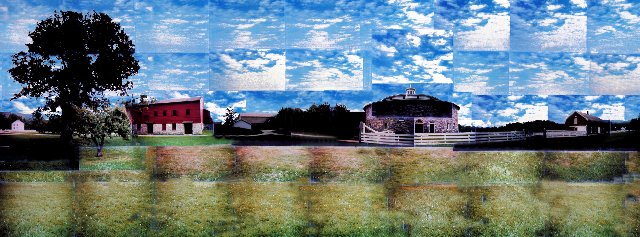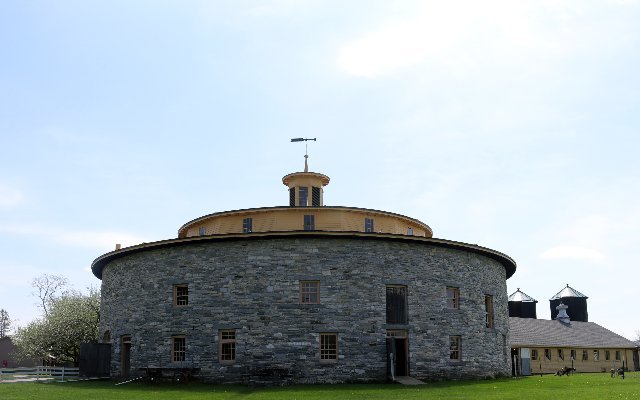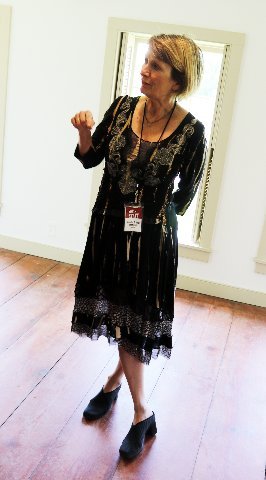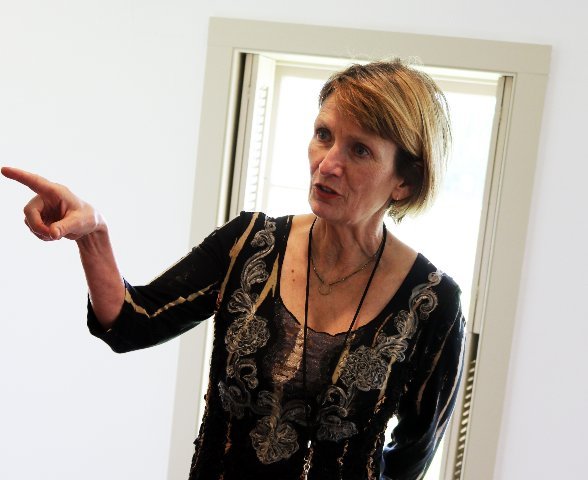Hancock Shaker Village a Living History Museum
Jennifer Trainer Thompson Discusses Plans for a 2020 Season
By: Charles Giuliano - Apr 23, 2020
In a normal season the Hancock Shaker Village, which was founded sixty years ago near Pittsfield, is open from April through December.
With spring planting and the birth of livestock this is a busy time of year. The annual Baby Animals Festival draws some 20% of annual visitation and 15% of earned revenue.
As director Jennifer Trainer Thompson told me if The Village is allowed to open in June, they hope to be able to salvage some of that event. Thinking creatively the Baby Animals are available as Zoom purchases.
When we spoke this week, she had been in the Round Barn streaming baby animals on Zoom for a birthday girl in New Jersey. With enthusiasm she told me that the Zoom events are “Selling like hot cakes.”
In addition to an update on sustaining through the Coronavirus disruption she sketched the fascinating history of the Shaker community in Hancock. In the 19th century it was one of 19 Shaker sites from Maine to Florida as well as Ohio.
The mantra of the celibate community, where men, women, and races were equal was “Hands to work, hearts to God.”
Charles Giuliano It’s springtime at Hancock Shaker Village. Tell us what that means?
Jennifer Trainer Thompson It’s very much alive. In the area around the round stone barn we have baby animals. There are animals being born nearly every day. We have baby goats, calves, and lambs. The baby pigs will come soon. We are starting to plant the gardens.
CG A Shaker business was selling seeds. Do you plant their heirloom crops?
JTT The Shakers were the first to packet seeds. When the railroad came through Pittsfield they set up a depot to get their seeds out into the world. We make their heirloom seeds available through the Berkshire Athenaeum. We plant the crops that the Shakers planted. Hops, for example, because they brewed their own beer. There are large traditional, perennial, medicinal herb gardens.
We plant five acres of vegetables. About ten years ago we instituted a Community Supported Agricultural Program. We have 65 shareholders or families that receive a weekly bag of produce. That’s five months a year. Last year we introduced a meat program.
About 15% of our produce we give to local food banks. Some weeks that may be two hundred pounds of carrots or other assorted things. With our CSA shareholders they accept the risk as well as the bounty as you never know.
The Village is about 750 acres. Our vegetable gardens are five acres and of course we also have livestock.
Last year we replaced five acres of fencing. It’s the three-rail design that the Shakers built. We don’t use pressure treated wood or use any chemicals on our land. It was an expensive project for which we raised money. I asked our farmer if anyone hops the fence to steal our vegetables? As the Shakers said when that happened, particularly in hard winters, “This year we need to plant another row.”
Four years ago, when I came as director we instituted an intern program. Seven college student or recent graduates were paid and our goal was to teach them about a living history museum. We have increased to ten interns and have been adding to that each year.
Last year we added farm and garden interns. They’re not just kids picking lettuce they are learning the acumen of running a small farm.
CG When did you become director?
JTT January, 2017.
CG What’s different and what have you initiated and planned?
JTT We’ve expanded the programming. We turned the hay loft into a Shaker Barn music concert venue. We have musicians like Natalie Merchant. We’ve ramped up the exhibitions programming. Changing exhibitions is a way to see the Shakers through a contemporary lens. We started an artist residency program.
CG Describe what was and how you changed that?
JTT What was entailed a beautiful property. My predecessor had taken great care to preserve twenty historic buildings. The hearth of one building dates back to the late 1700s. It’s no small feat to preserve these structures. I inherited an exquisite property and living history museum at a time where increasingly we were competing for people’s attention. They saw the baby animals ten years ago and thought they’d done that and didn’t need to come back.
In the past four years we’ve increased the programming and created new ways to experience the Shakers. Last year the artist-in-residence, Barbara Prey, spent five months creating a watercolor exhibition “Borrowed Light” of interior views. The Shakers believed that light was borrowed from God. Their architecture captured light with interior windows. That was a hundred years before it was done by other architects.
Through exhibitions and concerts, we’re trying to bring The Village alive and give people reasons to return. For example, we have two wooden silos. Farmers stopped making them from wood after WWII when fiberglass was introduced. I had been here for two weeks when my farmer came to me after there had been a huge storm. He said “They’re not going to make it through another storm.”
We raised the money to restore them. Have you ever been inside a silo?
CG Can’t say that I have.
JTT I hadn’t either. They’re beautiful. It’s a beautiful cylinder of wood and acoustically gorgeous. We commissioned Brad Wells; the founder of a contemporary music group called Room Full of Teeth. When the Shakers arrived before it was even the United States they were singing wordless songs. They didn’t want to be mistaken for other churches that had hymns.
The early Shaker songs are wordless and haunting. We have a number of them in our collection and there are a number of them in the collection of Williams College. We commissioned Brad to create a 28 minute score based on the early Shaker wordless songs. He commissioned a well-known musician, Sam Amidon, and the founder of the Carolina Chocolate Drops, Rhiannon Giddens, to sing them. When you walk into the silos you hear this music.
CG How many years were you with MASS MoCA?
JTT Twenty-eight.
CG You were involved with administration. To what extent did you have programming experience?
JTT I had a modest amount. We had annual NY Galas and would program that. We had David Byrne perform. When I started at MASS MoCA, I did development, membership, and PR.
CG To what extent has that experience and rolodex of contacts through development transfered to your position with Shaker Village? Particularly for fundraising, it would seem that you are calling on the same patrons and donors you contacted for MASS MoCA. That’s an advantage to finding another position in the Berkshires.
JTT Any job you ever had transfers to where you are in any given moment. I’m also the author of 20 books. (Checking Amazon the titles are primarily food, condiments, beverage, and travel related.) Three of them were co-authored. When I started at HSV I thought about what I wanted to experience there.
I started a program called Food for Thought. I contacted writers who were engaged in ideas with relevance. For example, I asked Governor Deval Patrick (a Berkshire neighbor) to address principles in politics. Elizabeth Kolbert wrote the book “Extinction.” She talked about global warming. The evenings include dinner, a copy of the book, and a chance to meet the author.
I think everything you do is informed by the past and what you bring to it. My point is that I was a writer with a lot of contacts at publishing houses and agents. I haven’t had a rolodex for years but I still think in terms of them. The little spinning ones.
CG Let’s talk about sex or the lack thereof. Celibacy was a paradigm for the Shaker life and a reason why the sect is now all but extinct. What is the positive of that?
JTT OK. There thinking was that everybody’s relation was equal. There were no hierarchies such as you would find living with married people. It was one of the tenets of Ann Lee who was the founder of the American branch of the Shakers. I was speaking with a Shaker scholar about this. There are three Shakers still living at Sabbathday Lake.
(Sabbathday Lake Shaker Village is a Shaker village near New Gloucester and Poland, Maine, in the United States. It is the last active Shaker community, with three members. The community was established in either 1782, 1783 or 1793, at the height of the Shaker movement in the United States.)
People could become a Shaker today. There are many people who choose not to have children. There are many people who opt not to marry or have sex. If you join the Shakers it’s a true community. Not many people choose to do that. He (the scholar) thought that during the industrial revolution people flocked to cities. Things were no longer made by hand (cottage industry) and they left farms. Our country is very individualistic and not communal oriented. I can’t explain it further but it was obviously an utopian ideal of theirs.
Often, it’s asked how there were Shaker children.? They would take in anyone. If a soldier died during the Civil War, and left a widow with five kids. they could show up on the doorstep at midnight and be taken in. They didn’t allow the children to call themselves Shakers. Once the children were adults, they had to make that decision on their own.
CG In the era of the Civil War the Shakers took in African Americans.
JTT That’s right. A hundred years before women had the right to vote they believed that men and women were equal. They also believed in racial equality. In the United States there were 19 villages from Maine to Florida and Ohio. They were known to buy slaves and free them. They harbored slaves. A free black woman, born in Philadelphia in the late 1700s, founded a black Shaker community in the 1820s.
As an example of our programming last summer we commissioned Reggie Wilson, an African American choreographer, and his group Fist and Heel Productions. With Jacob’s Pillow he developed a new work based on early black Shaker ecstatic worship. It premiered in the round stone barn and then at Pillow at the end of July. It was supposed to have its NY premiere at Brooklyn Academy of Music (BAM), actually, next week. (Late April)
CG What are plans for the summer of 2020?
JTT We’re closed as a museum. The farm is active but closed to the public. We will open as soon as the Governor allows it. We have more social distancing than any other museum with 20 separate buildings. Our barns are quite open. My farmer assures me that the animals will be babies at least until the end of June.
We have full schedule for the summer and, like everyone else, we’re adopting a wait and see approach. We have only cancelled things through May 15.
CG What are some of the highlights?
JTT There is a great Shaker Barn Music Series if we are allowed to do it. Billy Keane of the Whiskey Treaty Road Show is our curator. The schedule of concerts is on our website. This is our 60th anniversary so our curator has put together a wonderful exhibition.
The Shakers left Hancock in 1959. They tried to sell the property for $200,000. A developer planned to buy and level all of the buildings except the round barn. He was going to create a horse track around the barn. He had connections to the mob. Amy Bess Williams Miller, the wife of the owner of the Berkshire Eagle, caught wind of this. She put her husband’s company on the line as collateral. She borrowed $150,000 and went to the Shakers promising that she would turn the property into a museum.
(The daughter of a prominent Worcester physician, Amy Bess Williams Miller graduated from Miss Hall's, studied art history at the Sorbonne in Paris, and then returned to Pittsfield in 1933 as the bride of Lawrence K. Miller, whose family owned The Berkshire Eagle. Twenty- six years later, having raised three sons and a daughter, she transformed Hancock Shaker Village into an outdoor history museum. She was its unpaid president until she retired in 1990. She died in 2003 at age 90.)
This exhibition will talk a lot about that. It will have highlights of the last 60 years. We will have “By Design” another exhibition. It’s masterpieces from our collection combined with contemporary designers who are inspired by the Shakers.
CG How old is the site?
JTT They arrived in 1783 as recorded in journals. It was incorporated in 1790. That’s before the Treaty of Paris was signed. That’s before slavery was abolished in Massachusetts. It’s amazing to think that this is in our neighborhood. Today it’s a non profit like the Clark or other museums.
CG Is there any official connection with other Shaker sites?
JTT We’re friendly but all independent. Our curator is collaborative and makes a great effort to reach out to them. I don’t know all of the directors. The site in Sabbathday Lake, Maine is a museum and where Shakers actually still live.
(There was a 1998 Institute of Contemporary Art exhibition “Quiet in the Land.” Artists were invited for residences in which they participated in daily chores and meal preparation. On site they created works inspired by the experience. During the press opening we met with the artists as well as a few Shakers who attended the event. Curated by France Morin, among others, projects were created by Marina Abramovi?, Janine Antoni, Hans Georg Berger, Cai Guo-Qiang, Ann Hamilton, Manivong Khattiyarat, Dinh Q. Lê, Shirin Neshat, Jun Nguyen-Hatsushiba, Vong Phaophanit, Allan Sekula, Shahzia Sikander, Nithakhong Somsanith, and Rirkrit Tiravanija realized in Luang Prabang, Laos, Nari Ward and Chen Zehn.)
CG How many active sites are there?
JTT (Thinking and counting) There are several including New Lebanon, New York where most of the property is occupied by Darrow School. They have museum buildings but there are challenged.
There’s one near the Albany Airport. (Watervliet Shaker Historic District, in Colonie, New York was the first Shaker community established in 1776. The primary Shaker community, the Mount Lebanon Shaker Society, was started a bit later. Watervliet's historic 1848 Shaker meetinghouse has been restored and is used for public events, such as concerts.)
The Shakers arrived in New York and sailed up the Hudson settling in Colonie near Albany.
CG At the peak of the movement what was the Shaker population?
JTT That’s debated but estimates range between 5,000 and 6,000. That’s about half the people that visit Central Park on a sunny summer day. It’s small but you know what Shaker means. It means simplicity, integrity, reverence for the act of making. The impact they had is quite extraordinary.
CG You have a collection. If Shaker material is available do you have funds to acquire or strategies to seek donations? To what extent is the collection active and growing?
JTT We have a collections committee. The chairperson is Michael Conforti (former director of the Clark Art Institute). We have an acquisitions budget. There are about 22,000 objects in the collection. That includes works on paper. We are in the quite phases of finding ways to properly store the collection. Much is unseen and we would like to get more of it on view. We still accept donations.
We got a recent call from the widow of senator Daniel Patrick Moynihan (1927-2003). In 1958 he was a young lawyer in Albany. He had little kids and no money. Somebody said “Go see the Shakers and they’ll sell you furniture cheap.” He came here with a truck and bought a lot of furniture. On the way home, on Route 20, he was stopped by the cops. He was wearing a plaid jacket and cap that fit the description some dangerous guy on the lam. They left the truck by the side of the road and threw him in jail.
It took his wife three days to reach the governor and get him out. He went back and the truck was still there. They used the furniture for 55 years. It was used by their kids, grand kids. Mrs. Moynihan is now in her 90s and downsizing.
She called us and asked if we wanted some of the furniture? We did particularly for the story alone.
That’s typical and we acquire in many different ways. We might pursue a specific object that we want to fill out our collection. Sometimes we acquire objects for their provenance. You go into museums and do not know how many places an object has been before it got there. We’re fortunate that a lot of things that were made in Hancock are ending up there.
CG How much of the collection was made on site?
JTT I don’t know. It’s an interesting question and I can ask our curator.
CG In 1959 when the property was sold was there a body of furniture and objects as part of the transaction?
JTT There was and there was also a collecting couple in Pittsfield. They started in the 1930s and acquired a lot of Shaker material. We have a fair amount of their collection.
CG Today Shaker material is valued by collectors and museums. The simple inventive, pragmatic designs predate the form-follows-function aesthetics of Bauhaus design. That has greatly enhanced its aesthetic impact.
JTT You’re right. The Shakers have influenced furniture makers and designers. There was such a reverence for form. They had an expression “Hands to work; Hearts to God.” Making a chair was a form of worship. When you experience a piece of Shaker furniture you can sense its tremendous love in the making of it. Shaker design right now is having a resurgence.
At Art Basel in Miami, two years ago for the first time, there was a Shaker booth of 19th century artifacts. We took some of our donors to Miami to see and experience that.
That’s one of the reasons we’re doing the show “By Design.” It’s about the enduring quality of the Shaker legacy. We include 16 contemporary designers who sometimes literally, and sometimes spiritually or philosophically, have been influenced by the Shakers. The design room in Soho of Design Within Reach includes a big picture window. The only object ever displayed in that window that wasn’t one of theirs’ was a Shaker piece during Design Week. It was a 19th century Shaker stove that was designed and built at Hancock.
CG They were notable for inventions like the round barn. They were known for simplicity and functionality of design.
JTT That’s right. They were always refining and designing. When the round barn burned down, when they were rebuilding, they added another ten feet to the roofline. They were always striving for perfection. There was functional and spiritual intent in all that they produced. The spiritual manifested itself through the object.
All of the materials for the round barn were from the property. The stone came from their quarry in the Southern area of the property in Richmond. The yellow paint was from a vein of ochre in the stone.
They made the barn round for a couple of reasons. There is 360-degree ventilation and sunlight. They built it into the bank of the hillside. At all three levels you can drive around the circumference with a team of horses and not back up which was extremely dangerous.
Also, they used gravity driving a team in at the top level. They pitched hay down into the center area. One level below that they pulled the hay through pilasters to feed fifty-seven cows. One farmer could work around and milk all of the cows.
There were trap doors to the cellar where the manure dropped and formed a compost pit. It was such a radical design that the whole community had to reach consensus. Later it was world renowned and became one of the first Berkshire buildings on the National Historic Register in the 1960s.
CG What staff, salary and budget adjustments have you had to make with the museum closed because of the pandemic. With no visitation that’s a loss of revenue. What are the administrative strategies at this time?
JTT During the winter we are leaner than the season when we are open from April to December. Because it happened in March the impact was less severe. We had 22 on staff with many of them working on maintenance and part time in the barn. We reduced to a staff of ten. Those of us who earn more than minimum wage our salaries have been reduced some 10% to 35%. We have reduced the budget as much as we can.
The board and I have worked hard, as did my predecessor, to stabilize The Village. We have a small endowment. We didn’t go into this (pandemic) with any debt or a mortgage. We are trying to be prudent, thrifty Yankees to get through this.
Baby Animals represents about 20% of our visitation and about 15% of our revenue. The three-week festival is really important to us. Thousands of people come for it. If we are able to open in June and save some of Baby Animals we will be in better shape than if we can’t.
Like everyone else we’re doing everything we can. Perhaps you’ve noticed we’ve started to sell having baby goats and lambs at your Zoom meeting. That’s beginning to sell like hot cakes. I was in the barn at 11 AM today. There was a girl from New Jersey having her 14th birthday and we did a Zoom from the barn for her birthday party. We’re trying to be creative.
CG Can you talk to me about the endowment?
JTT I probably shouldn’t but we’re always exploring revenue sources. You can see our solar panels on about 30 acres. That’s leased so it’s an endowment-like equivalent. We are trying to use our natural resources as best we can with our 750 acres. At the same time, we are trying to grow the endowment and certainly not ignoring it.
CG Before this lockdown was the campus set? Were there plans for renovation and expansion for example of exhibition and retail space? I recall that there were plans to expand the museum. Is that true?
JTT Yes. We were in the quiet phase of a campaign to open up the second floor of the Visitor’s Center. The plan is to create proper, year-round collection storage. It will be handicap accessible and increase exhibition space. There will be more opportunity for visitors to see what’s on view. It would allow us to open another floor of The Brick Dwelling for exhibition and visitation.
We are about a third of the way toward our financial goal. We were on track to finish that this year. There is a temporary pause on that until we get through this situation. It’s definitely on the horizon.
CG Thank you for your time and this has been a wonderful history lesson.




